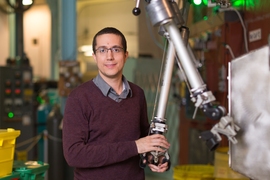Years before he set foot on the MIT campus, Kieran P. Dolan participated in studies conducted at MIT's Nuclear Reactor Laboratory (NRL). As an undergraduate student majoring in nuclear engineering at the University of Wisconsin at Madison, Dolan worked on components and sensors for MIT Reactor (MITR)-based experiments integral to designing fluoride-salt-cooled high-temperature nuclear reactors, known as FHRs.
Today, as a second-year doctoral student in MIT's Department of Nuclear Science and Engineering, Dolan is a hands-on investigator at the NRL, deepening his research engagement with this type of next-generation reactor.
"I've been interested in advanced reactors for a long time, so it's been really nice to stay with this project and learn from people working here on-site," says Dolan.
This series of studies on FHRs is part of a multiyear collaboration among MIT, the University of Wisconsin at Madison, and the University of California at Berkeley, funded by an Integrated Research Project (IRP) Grant from the U.S. Department of Energy (DOE). The nuclear energy community sees great promise in the FHR concept because molten salt transfers heat very efficiently, enabling such advanced reactors to run at higher temperatures and with several unique safety features compared to the current fleet of water-cooled commercial reactors.
"Molten salt reactors offer an approach to nuclear energy that is both economically viable and safe," says Dolan.
For the purposes of the FHR project, the MITR reactor simulates the likely operating environment of a working advanced reactor, complete with high temperatures in the experimental capsules. The FHR concept Dolan has been testing envisions billiard-ball-sized composites of fuel particles suspended within a circulating flow of molten salt — a special blend of lithium fluoride and beryllium fluoride called flibe. This salt river constantly absorbs and distributes the heat produced by the fuel's fission reactions.
But there is a formidable technical challenge to the salt coolants used in FHRs. "The salt reacts with the neutrons released during fission, and produces tritium," explains Dolan. "Tritium is one of hydrogen’s isotopes, which are notorious for permeating metal." Tritium is a potential hazard if it gets into water or air. "The worry is that tritium might escape as a gas through an FHR's heat exchanger or other metal components."
There is a potential workaround to this problem: graphite, which can trap fission products and suck up tritium before it escapes the confines of a reactor. "While people have determined that graphite can absorb a significant quantity of hydrogen, no one knows with certainty where the tritium is going to end up in the reactor,” says Dolan. So, he is focusing his doctoral research on MITR experiments to determine how effectively graphite performs as a sponge for tritium — a critical element required to model tritium transport in the complete reactor system.
"We want to predict where the tritium goes and find the best solution for containing it and extracting it safely, so we can achieve optimal performance in flibe-based reactors," he says.
While it's early, Dolan has been analyzing the results of three MITR experiments subjecting various types of specialized graphite samples to neutron irradiation in the presence of molten salt. "Our measurements so far indicate a significant amount of tritium retention by graphite," he says. "We're in the right ballpark."
Dolan never expected to be immersed in the electrochemistry of salts, but it quickly became central to his research portfolio. Enthused by math and physics during high school in Brookfield, Wisconsin, he swiftly oriented toward nuclear engineering in college. "I liked the idea of making useful devices, and I was especially interested in nuclear physics with practical applications, such as power plants and energy," he says.
At UW Madison, he earned a spot in an engineering physics material research group engaged in the FHR project, and he assisted in purifying flibe coolants, designing and constructing probes for measuring salt's corrosive effect on reactor parts, and experimenting on the electrochemical properties of molten fluoride salts. Working with Exelon Generation as a reactor engineer after college convinced him he was more suited for research in next-generation projects than in the day-to-day maintenance and operation of a commercial nuclear plant.
"I was interested in innovation and improving things," he says. "I liked being part of the FHR IRP, and while I didn't have a passion for electrochemistry, I knew it would be fun working on a solution that could advance a new type of reactor."
Familiar with the goals of the FHR project, MIT facilities, and personnel, Dolan was able to jump rapidly into studies analyzing MITR's irradiated graphite samples. Under the supervision of Lin-wen Hu, his advisor and NRL research director, as well as MITR engineers David Carpenter and Gordon Kohse, Dolan came up to speed in reactor protocol. He's found on-site participation in experiments thrilling.
"Standing at the top of the reactor as it starts and the salt heats up, anticipating when the tritium comes out, manipulating the system to look at different areas, and then watching the measurements come in — being involved with that is really interesting in a hands-on way," he says.
For the immediate future, "the main focus is getting data," says Dolan. But eventually "the data will predict what happens to tritium in different conditions, which should be the main driving force determining what to do in actual commercial FHR reactor designs."
For Dolan, contributing to this next phase of advanced reactor development would prove the ideal next step following his doctoral work. This past summer, Dolan interned at Kairos Power, a nuclear startup company formed by the UC Berkeley collaborators on two DOE-funded FHR IRPs. Kairos Power continues to develop FHR technology by leveraging major strategic investments that the DOE has made at universities and national laboratories, and has recently started collaborating with MIT.
"I've built up a lot of experience in FHRs so far, and there's a lot of interest at MIT and beyond in reactors using molten salt concepts," he says. "I will be happy to apply what I've learned to help accelerate a new generation of safe and efficient reactors."









